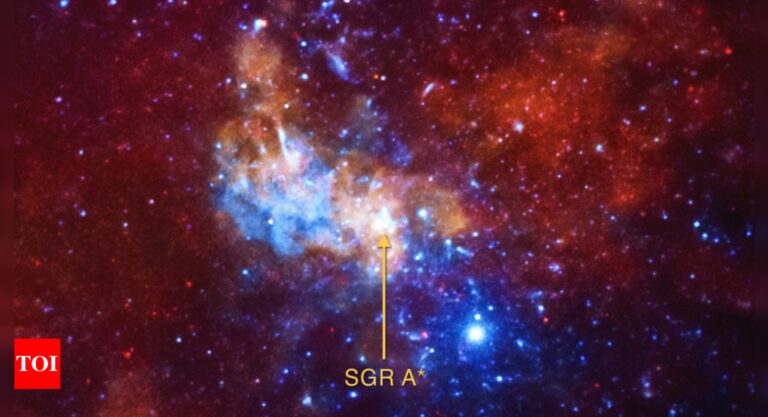
[ad_1]
Nasa’s Chandra X-ray Observatory Reveals Milky Way‘s Black Hole Spinning at High Speeds
CAMBRIDGE: A groundbreaking study utilizing data from Nasa’s Chandra X-ray Observatory and the National Science Foundation’s Karl G. Jansky Very Large Array (VLA) has unveiled that the supermassive black hole at the center of our Milky Way galaxy, Sagittarius A* (Sgr A*), is spinning at such a rapid pace that it’s warping the surrounding spacetime, likening it to a football shape.
Located approximately 26,000 light-years from Earth, Sgr A* exhibits a spin with an angular velocity about 60% of the maximum possible, challenging previous estimates of its rotation speed. “Our work may help settle the question of how fast our galaxy’s supermassive black hole is spinning,” stated Ruth Daly of Penn State University, the lead author of the study. “Our results indicate that Sgr A* is spinning very rapidly, which is interesting and has far-reaching implications.”
This rapid rotation affects the spacetime and matter around the black hole, potentially leading to significant outflows or jets when the conditions around Sgr A* change. “A spinning black hole is like a rocket on the launch pad,” explained Biny Sebastian from the University of Manitoba. “Once material gets close enough, it’s like someone has fueled the rocket and hit the ‘launch’ button.”
The implications of such activity extend beyond the vicinity of the black hole, potentially impacting the gas supply of the entire galaxy and influencing star formation rates. “Jets powered and collimated by a galaxy’s spinning central black hole can profoundly affect the gas supply for an entire galaxy,” added co-author Megan Donahue from Michigan State University.
The study’s findings, published in the January 2024 issue of the Monthly Notices of the Royal Astronomical Society, were derived using an innovative “outflow method” that combines X-ray and radio data with an independent estimate of the black hole’s mass. This method provides a more accurate constraint on the black hole’s spin, offering new insights into the behavior of Sgr A* and its potential future activity.
“We have a special view of Sgr A* because it is the nearest supermassive black hole to us,” said co-author Anan Lu from McGill University. “Although it’s quiet right now, our work shows that in the future it will give an incredibly powerful kick to surrounding matter.”
This research underscores the importance of continued observation and study of Sgr A*, providing a glimpse into the dynamic processes at the heart of our galaxy.
CAMBRIDGE: A groundbreaking study utilizing data from Nasa’s Chandra X-ray Observatory and the National Science Foundation’s Karl G. Jansky Very Large Array (VLA) has unveiled that the supermassive black hole at the center of our Milky Way galaxy, Sagittarius A* (Sgr A*), is spinning at such a rapid pace that it’s warping the surrounding spacetime, likening it to a football shape.
Located approximately 26,000 light-years from Earth, Sgr A* exhibits a spin with an angular velocity about 60% of the maximum possible, challenging previous estimates of its rotation speed. “Our work may help settle the question of how fast our galaxy’s supermassive black hole is spinning,” stated Ruth Daly of Penn State University, the lead author of the study. “Our results indicate that Sgr A* is spinning very rapidly, which is interesting and has far-reaching implications.”
This rapid rotation affects the spacetime and matter around the black hole, potentially leading to significant outflows or jets when the conditions around Sgr A* change. “A spinning black hole is like a rocket on the launch pad,” explained Biny Sebastian from the University of Manitoba. “Once material gets close enough, it’s like someone has fueled the rocket and hit the ‘launch’ button.”
The implications of such activity extend beyond the vicinity of the black hole, potentially impacting the gas supply of the entire galaxy and influencing star formation rates. “Jets powered and collimated by a galaxy’s spinning central black hole can profoundly affect the gas supply for an entire galaxy,” added co-author Megan Donahue from Michigan State University.
The study’s findings, published in the January 2024 issue of the Monthly Notices of the Royal Astronomical Society, were derived using an innovative “outflow method” that combines X-ray and radio data with an independent estimate of the black hole’s mass. This method provides a more accurate constraint on the black hole’s spin, offering new insights into the behavior of Sgr A* and its potential future activity.
“We have a special view of Sgr A* because it is the nearest supermassive black hole to us,” said co-author Anan Lu from McGill University. “Although it’s quiet right now, our work shows that in the future it will give an incredibly powerful kick to surrounding matter.”
This research underscores the importance of continued observation and study of Sgr A*, providing a glimpse into the dynamic processes at the heart of our galaxy.
[ad_2]
